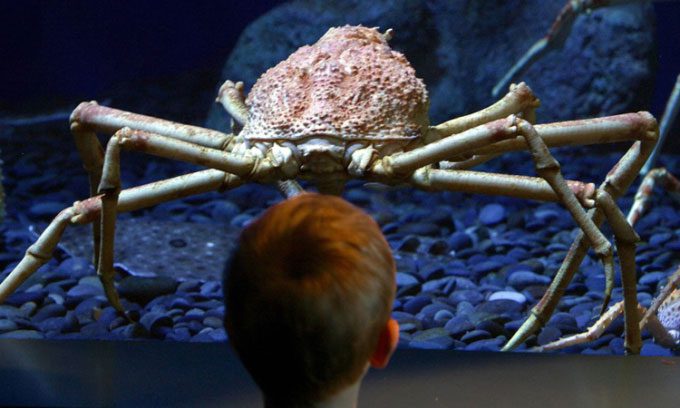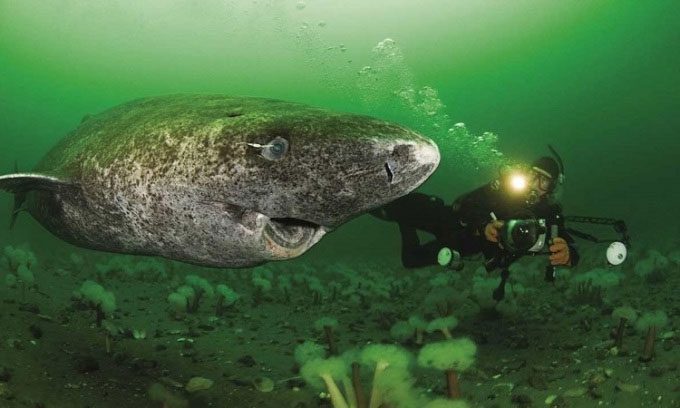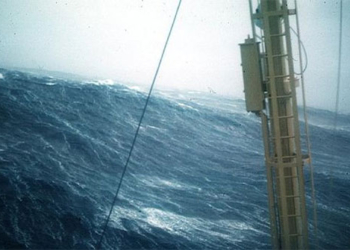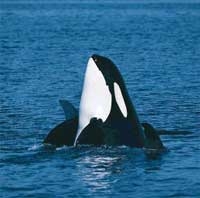Many deep-sea animals are significantly larger than their relatives elsewhere, possibly due to environmental factors or survival purposes.
In the deepest and coldest parts of the ocean, marine creatures—primarily invertebrates—can reach gigantic sizes. Squids, sea spiders, worms, and many other animals grow much larger than their counterparts around the world. This phenomenon is known as gigantism.

A 3-year-old boy in Los Angeles observes a giant spider crab at the Pacific Aquarium in Long Beach, California, USA, in 2004. (Photo: Robyn Beck/AFP)
For example, the colossal squid (Mesonychoteuthis hamiltoni) found in the waters near Antarctica can be about 14 times longer than the arrow squid (Nototodarus sloanii) found in New Zealand. Deep in the Pacific Ocean, there exists a sponge that is the size of a minivan. What in the deep, frigid waters leads these creatures to grow so large? According to scientists, it may be a matter of survival, and the factors present in these extreme cold waters allow gigantism to occur.
In the deepest parts of the ocean, resources are extremely limited, much like in island ecosystems, according to a study published in the journal Biogeography. Most food originates from shallower waters, and only a small fraction makes its way down to the deep sea. When food is scarce, enormous size provides a significant advantage, according to Alicia Bitondo, an expert at the Monterey Bay Aquarium in California, USA.
Larger animals can move faster and farther in search of food or mates. They also have more efficient metabolic mechanisms and better food storage capabilities. Thus, when large carcasses sink to the deep sea, giant predators can consume more and store that energy for longer periods.

The Greenland shark has a very slow metabolism. (Photo: Dive Magazine)
The cold temperatures of the deep sea may also promote gigantism by significantly slowing down the metabolic processes of animals. Creatures in this ecosystem often grow and mature very slowly; for example, the Greenland shark (Somniosus microcephalus), Bitondo explains.
The Greenland shark can grow up to 7.3 meters in length and weigh 1.4 tons, but their growth spans centuries. They grow about 1 cm per year and only reach reproductive age after living for approximately 150 years. The longevity and large size of Greenland sharks may be partly due to the absence of predators in the deep sea.
Before encountering the deep-sea “giants”, humans have observed them near Antarctica. Around the Antarctic continent, gigantism occurs closer to the surface. There are species of sea slugs, sponges, worms, sea spiders, and even giant single-celled organisms living here. They exist within diving range, only about 9 meters deep, according to Art Woods, a professor at the University of Montana.
“Something in Antarctica may have allowed these giant species to live closer to the water’s surface,” Woods said. He believes that the gigantism in Antarctica may be related to the oxygen supply in the frigid waters surrounding the continent.
These polar waters have high oxygen concentrations, according to the U.S. Geological Survey (USGS). However, animals in this environment consume oxygen very slowly because cold water reduces metabolic rates, Woods explains. Since the abundant oxygen supply far exceeds the animals’ needs, growth limits may have been lifted.
“The environment allows them to grow larger body sizes and tissue sizes without suffering from oxygen deficiency,” Woods said. While the plentiful oxygen supply does not necessarily drive marine organisms to become gigantic, it facilitates the process.
However, even among the giants in polar regions, there seems to be a limit to their size. In a study published in the journal Proceedings of the Royal Society B in 2017, Woods and colleagues studied the Arctic giant sea spider, which can reach lengths of up to 30.5 cm.
The research team found that larger sea spiders had lower oxygen levels in their bodies. Aerobic metabolism depends on the oxygen supply. If oxygen levels drop too low, tissues will be affected. The reduced oxygen levels in larger sea spiders suggest that something changes in the balance between oxygen supply and demand. “You can imagine that the spiders reach a size where they cannot take in enough oxygen. At that point, the larger ones start to hit a growth limit,” Woods said.
While there are many hypotheses about the various factors that create marine giants, no theory is certain about the precise mechanisms governing these dramatic evolutionary changes in body size. “In biology, we say that nothing is certain,” Woods shared.





















































